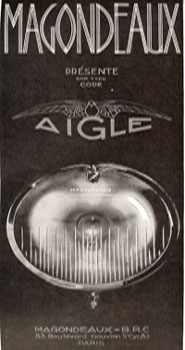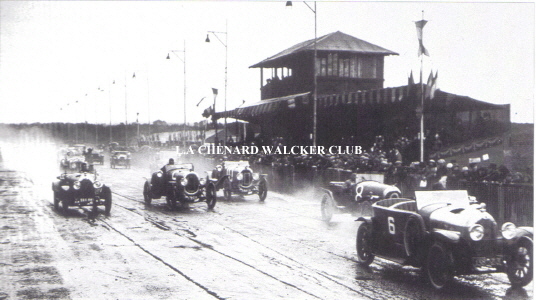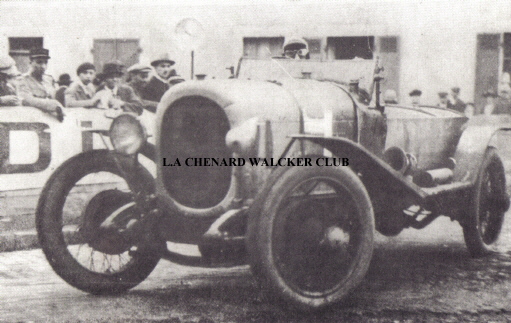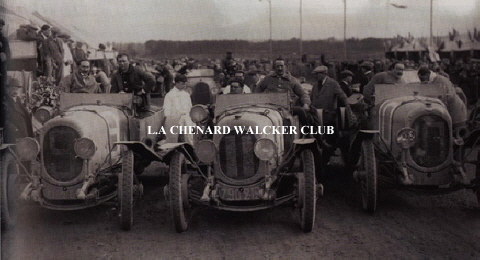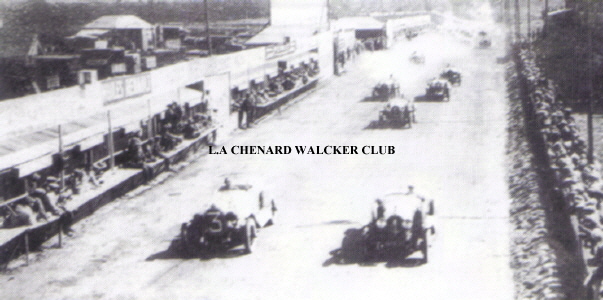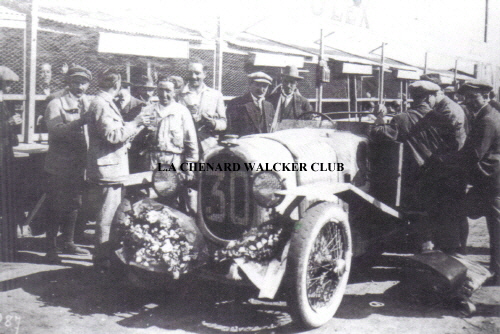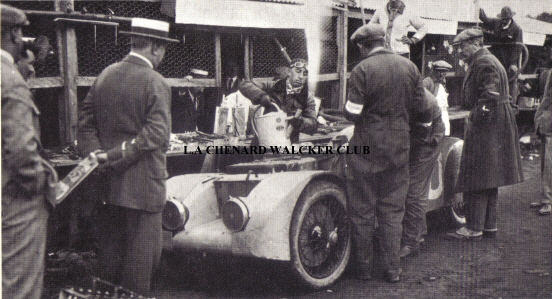|
|
|
||||||||||||||||||||||||||||||||||||||||||||||||||||||||||||||||||||||||||||||||||||||||||||||||||||||||||||||||||||||||||||||||||||||||||||||||||||||||||||||||||||||||||||||||||||||||||||||||||||||||||||||||||||||||||||||||||||||||||||||||||||||||||||||||||||||||||||||||||||||||||||||||||||||||||||||||||||||||||||||||||||||||||||||||||||||||||||||||||||||||||||||||||||||||||||||||
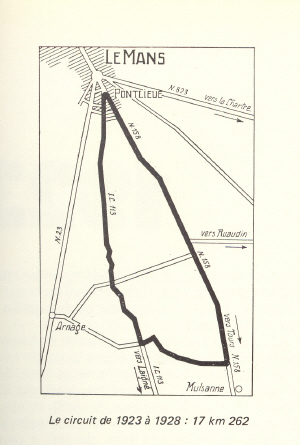 |
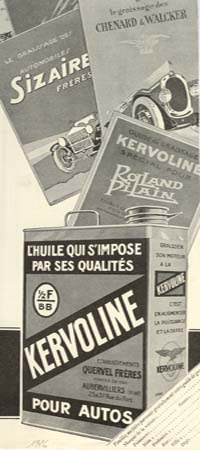 |
||||||||
|
Le Mans |
||||||||
|
1925 |
||||||||
 |
||||||||
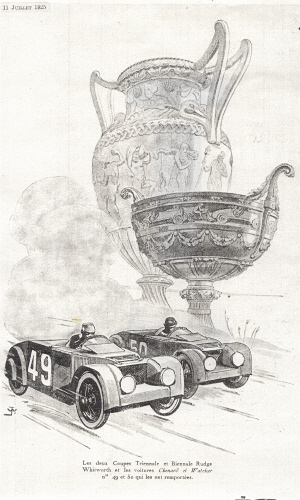 |
||||||||
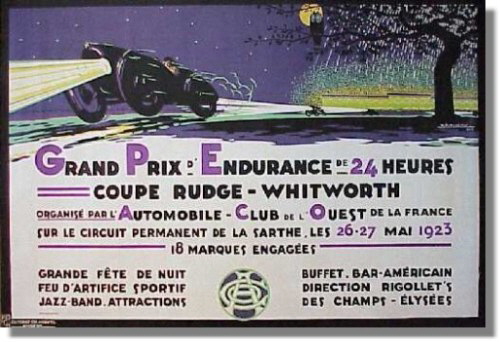 |
||||||||||||||||||||||||
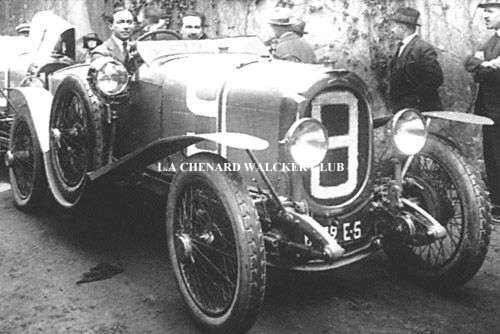 |
||||||||||||||||||||||||
|
At the wheel the ingenior, pilot and team’s chief André Lagache, next to René Leonard, the headmaster of the people who test the cars. |
||||||||||||||||||||||||
|
Victory of the first 24h of Mans. |
||||||||||||||||||||||||
|
A twenty four hours race? A daring and winning bet for Emile Coquille, Georges Durand (Active general secretary of “Automobile Club de l’ Ouest”), and for the famous cars journalist named Charles Faroux, author the race’s rules which we can remind the most important: 1) The engaged cars must be in conformity to the description given in the year’s catalogue published by their constructor. 2) The body of the car must comprise: The wings, the footboard, the headlights, the lanterns, the hood, the horn, the retrovisor, the windshield... In short, all what comprises a regular car.
Summary of the race: The race, only announced on February, namely three months before the date, was a big challenge. Thirty five cars representing eighteen brands were engaged. Chenard’s team gave three cars with a capacity of three liters to its pilots.There were: The car number ninth of Lagache and Léonard, the number tenth of R.Bachmann and Dauvergne, and the number eleventh of F.Bachmann and Glaszmann The type of cars of the team was U3. They own an engine of 79,5 x 150 milimeters of cubic capacity. The heading camshafts and the double lighting of the engine were assured by magneto. The engine’s power was from ninety to one hundred horsepower. The start was given at 4 PM under a shower of rain, in front of a large audience, on May 26th of 1923. After a few laps, the road was becoming a giant mud pit and the wheels where digging deep ruts. It was not easy to follow another car in those conditions. However, the battle between the cars was still amazing.
Ever since the first laps, the number ninth and and tenth were the leaders, pursued by the Bignan of De Tornaco and of Gros As it was thought it would be, the overnight part of the race plays an important role because the electricity failures caused numerous light problems in the cars. Actually, a few pilots had to drive without phares until the rise of the sun. Taking advantage of the sunlight, the English Bentley of Duff and Clément took the second place. Unfortunately, their car got out of the road in Mulsanne, and they lost precious time. Added to a gas important need, their doubts grew fast.
On Sunday, at 4 PM, when the checker flag dropped, Lagache and Léonard are the first who realised the 2209 kilometers at approximately 92,064 Kilometers per hour of speed. General classification : 1st. Lagache-Léonard Chenard-Walcker 2nd. Bachmann-Dauvergne Chenard-Walcker 3rd. De Tornaco-Gros Bignan 7th. Bachmann - Glaszmann Chenard-Walcker The three chenard & walcker at the arrival, signed the beginning of a very long serie of prestigious victories, for the french mark senior of the french motorcars “ The eagle takes its take- off “
|
||||||||||||||||||||||||
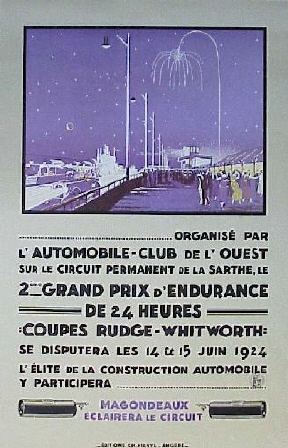 |
||||||||||||||||||||||||
|
From the very start of 1924, the Car club of France and West announced that the great price of Mans, which was founded, last year, for a triennial cut, will also have, this year, a biennial cut. The triennial one will be gained by the firm which will gain the great price three consecutive years and the biennial one, for two consecutive victories and it, following a formula holding account of the cubic capacity .
The Chenard house engaged six cars: a new 8 cylinders of 4 liters, one 3 liters two 2 liters and two 1500 Cm3, all new models, but not for the 3 liters. Settlement contains not a lot of changings: the tanks with gasoline, oils and water will be leaded and could not be supplied any more (only every twenty turns, every three hundred kilometers), two pilots per car were able to take turns at will . |
||||||||||||||||||||||||
|
And now we will live the race thanks to the account of André PISART, pilot of one of the two liters. 5,4,3,2,1 minutes; 30 seconds, etc. At four hours precise, the departure is given. In an infernal noise, an unbelievable dust, the racing cars leap.
Dauvergne misses his starting; “Of a blow of accelerator, I am before him and I extremely tighten at my right not to be hung, dust is so thin, at the first turn, I see with sorrow the 3 Chenard liters, turned over. Bachmann, trained by the mob, blind by dust, tooks his turn too quickly, the car made a slew-round... Fortunately, because that allowed the public to flee. The car finished its race being turned over in the ditch. The pilot by miracle is unharmed. Lagache is the leader and beats the record of the turn followed by Bignan, Bentley and me. My car works splendidly well and turns to more than 100 of average. After three hours of race, my engine is lighting by itself, my candles will be changed at the time of the supply. At eight hours, when I lead to the straight line, I see from far, an immense column of smoke and gigantic flames. I have a presentiment;... in a few seconds, I see the car, the 4 Chenard liters is in fire and is nothing any more but one torch. Lagache, on the roadside, makes me sign that he is allright. Bignan cars are the leaders, Chavée relays me until midnight, then I take the steering wheel back. Donnay and Lucien Chenard are awfully nervous; their 4 and 3 liters are out race and the two 1500 Cm3 disappear a little later, the seats from valves roasted. De Zuniga stops, he would like to be relayed, He burned his hand... No Dauvergne, He has to be called by the high speaker. The car loses two turns. At dawn, the three bignan and Bentley give up. The speed has been faster than the year before, the road did not resist, I lose my gasoline tank which I must replace and I also lose half of my carossery, but mechanic air as fresh as at the beginning. At midday, I give the steering wheel to Chavée, who will finish. At three hours and half, my car does not pass any more. The high speaker announces that it is broken down on the straight line of Hunaudières, the servo-brake blocked. There remain nothing any more but the 2 liters of Dauvergne, which is driven by Zuniga but to three meter before the arrival, the car stops, the servo-brake blocked too! There is not even one car which passes the finishing line. It is consternation everywhere. Faroux joins together his commisaires, they make the decision to classify with traversed mileage and to save thanks to this, their race for the following year. If Bentley makes the greatest number of mileage (below the previous year), I am the winner of category 2 liters.
The evening a large banquet joins us together, everyone is happy at Chenard, but it is not a true victory, and a little of melancholy reigns. What comforts them is that, from the point of view of publicity, they are nevertheless the winners, during two consecutive years, of the hardest test which ever existed.” A.Pisart. |
||||||||||||||||||||||||
|
General classification 1st. Duff-Clément Bentley 2nd. Stoffel-Brisson Lorraine 3rd. De Courcelles-Rossignol Lorraine 4th. Pisart-Chavée Chenard-Walcker 5th. Dauvergne-De Zuniga Chenard-Walcker |
||||||||||||||||||||||||
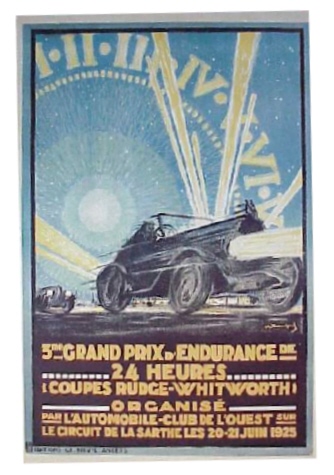 |
||||||||||||||||||||||||
|
In 1925, Chenard’s program of competition is particularly tough: Winning for the third time and consecutively the grand prix of Le Mans and Boulogne, and thus, ensure to win the definitive trophees. Not easy... Also the workshops, the engineering and design departments, and the engineers have too much work in the end of 1924.
Lucien Chenard put in manufacture three cars of four liters and eight cylinders. Two would be on the track of Le Mans, the other one would remain in reserve if needed. On another side, the chief engineer named Toutée, drew and built three little 1100 cm3 cars, descendants of the car of two liters of Boulogne. Four cylinder engine with front valves, exhaust, double oil circulation, very multiplied limp with four speeds, semi-direct direction, bridge without differential, simple mechanical brakes, unique clutch with dry disc, for the body that remains as the tank. The car is litterary with short-nap cloth of the ground, the pilot is completly locked up, and only his eyes can be seen. It is the most fantastic realisation that the car’s world knows, and even nowadays, nothing can be compared to it. The engine gives “50 CV”/liter, and it is the biggest output obtained with turbo-compressor. But two different types of car generate a noticable tension between Lucien Chenard and Toutée, even hough they both work in the same factory. On the first hand Lucien defends the first plan of his father, because he collaborated with him, and on the other hand, Toutée defends his child. “La maison Chenard” gives two 4 liters to Lagache - Léonard et de Pisart - Ledure The “1100” are given to Sénéchal - Loqueheux and Glaszmann - De Zuniga The D-day arrives and 49 cars will run. On Saturday morning, Guilbert, driving his Ravel car to the place of the race, dies. All the important competitors of the last years are here for the finale: Bentley (the eternal rival of Chenard), Amilcar, Peugeot, Georges Prat, Fiat, Licorne, Bignan, Lorraine-Dietrich, etc, etc As the shot bangs, Pisart directly becomes the leader, but at the 7th lap, after the platforms, on the straight line called “Hunnaudières” and a little before the Mulsanne turn, Marius Mestivier with his Amilcar is ahead of him. He is running after him, ready to get back his first place but he suddenly sees the car of Mestivier turning over, the back raising the front. The unfortunate pilot dies. The Chenard of Pisart is smelling smoke a lot and is beginning to slow down. The engine tightens more and more. He decides to stop, looks inside the cap but the rubber water connection is split. All the water is left. He lets time for the engine to cool and then tries to restart the car, but there’s nothing to do, but ti is seized up. He rejoins his stand by feet, with melancholy.
Lagache continues after Pissart and is leading the race. He is driving very fast. Suddenly, he stops at the stand, raise up the cap, and finds out he has the exact same problem as Pisart; namely, the rubber water connection is split. It is impossible to change it since, according to the rules it is forbidden to add some water in the radiator before the 20 first laps of each pilot’s car. However he has made 12 laps at the time, so he decides to slow down and try to make the 8 other laps without water. Then a long and monotonous time begins for him, but it will not last for a long time, because even though all his efforts, a piston seizes up. As a result, the two “four liters” are out. Panics in the stand. They decide to make the two “1100 cm3” tanks make a stop which are at their 14th lap. The pilots are not aware of anything yet. After having raised up the caps, the mechanics find out the same problem as well for the tanks, the rubber water connection is about to break. One more lap, and only one Chenard would have stayed in the race! They protect the connections with an insulating fabric, in order to be able to wait until the 20th lap, so the pilots start again, but they will not drive very fast on purpose. When finally they get to good lap, they can change these cursed conenctions. Meanwhile a Sunbeam is leading, and in the Bentley’s stand, the concern is important because the pilot Moir just gave up because of a breakdown and their other pilot named Duff is also facing problems since he losed five laps in the stand because of his oil system is broken.
The Chenard tanks begin something fantastic, Sénéchal drives so well that after hours of a difficult work, he leads the Triennal cup. Loqueheux gives back the wheel to Sénéchal at 2AM but forgets to tell his ally there is a lot of fog in the “S” of Arnage (a part of the road). Sénéchal arrives at this part very fast in the turns and ends up in a field! With a lot of courage and strength he builds a litlle bridge with boards he finds in order to pass over a ditch and return to the race. He succeeds and starts again, he is angered. Also, the list of abandonments grows fast with for example the accident of the Lorraine of Bloch-St.Paul, and the Bentley of Clément, victim of a fire. One hour before the end, there are only 25 cars remaining on the track, the race seems already over after the abandonment of the two “four liters” Chenard. De Courcelles-Rossignol gives to Lorraine its first victory in the Mans. 16 cars finish, this time the road was perfect. No one will ignore that Sénéchal won in his category and that his exploit was noticeable, and it is as a grand winner that he ends the race, followed by Glaszmann, who also did a splendid race. Chenard-Walcker’s team, after all the difficulties, finally wins the Triennal and Biennal cups, that are very coveted cups.
General classification : 1st. De Courcelles-Rossignol Lorraine 2nd. Chassagne-Davis Sunbeaum 3rd. Stalter-Brisson Lorraine M.T : Lagache Chenard-Walcker 112,987 km Biennal cup: 1st. Glaszmann - De Zuniga Chenard-Walcker 2nd. De Courcelles-Rossignol Lorraine 3rd. Slalter-Brisson Lorraine Triennial cup: 1st. Sénéchal-Loqueheux Chenard-Walcker 2nd. Sire-de Marguenat Rolland-Pillain 3rd. Slalter-Brisson Lorraine
|
||||||||||||||||||||||||
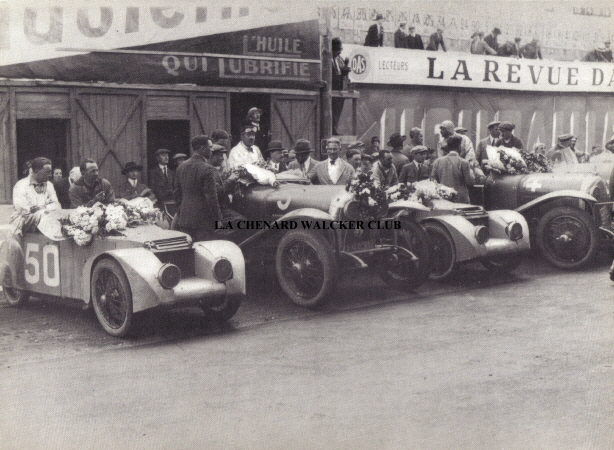 |
||||||||||||||||||||||||
 |
||||||||||||||||||||||||

